- Home
- Julia Child
Mastering the Art of French Cooking, Volume 2
Mastering the Art of French Cooking, Volume 2 Read online
BY JULIA CHILD, SIMONE BECK, AND LOUISETTE BERTHOLLE
Mastering the Art of French Cooking (1961)
VOLUME ONE
BY JULIA CHILD
The French Chef Cookbook (1968)
From Julia Child’s Kitchen (1975)
Julia Child & Company (1978)
Julia Child & More Company (1979)
The Way to Cook (1989)
Cooking with Master Chefs (1993)
In Julia’s Kitchen with Master Chefs (1995)
Julia’s Kitchen Wisdom (2000)
My Life in France, with Alex Prud’homme (2006)
BY JULIA CHILD AND JACQUES PÉPIN
Julia and Jacques Cooking at Home (1999)
BY SIMONE BECK
Simca’s Cuisine (1972)
These are Borzoi Books, published in New York by Alfred A. Knopf
Illustrations by
SIDONIE CORYN
BASED ON PHOTOGRAPHS BY PAUL CHILD
WHO ALSO CONTRIBUTED 36 DRAWINGS TO THE TEXT
VOL. 11
PUBLISHED OCTOBER 22, 1970
HARDCOVER EDITION REPRINTED THIRTY-SEVEN TIMES
THIRTY-NINTH PRINTING, JANUARY 2011
* * *
THIS IS A BORZOI BOOK
PUBLISHED BY ALFRED A. KNOPF, INC.
* * *
Copyright © 1970, 1983 by Alfred A. Knopf, Inc. All rights reserved under International and Pan-American Copyright Conventions. Published in the United States by Alfred A. Knopf, Inc., New York, and simultaneously in Canada by Random House of Canada Limited, Toronto. Distributed by Random House, Inc., New York. Manufactured in the United States of America
Library of Congress Cataloging in Publication Data
Child, Julia.
Mastering the art of French cooking.
Rev. ed. of: Mastering the art of French cooking
by Simone Beck, Louisette Bertholle, Julia Child.
Vol. 2 by Julia Child and Simone Beck.
Includes index.
1. Cookery, French. I. Bertholle, Louisette.
II. Beck, Simone. III. Beck, Simone.
Mastering the art of French cooking. IV. Title.
TX719.C454 1983 641.5944 83–48113
ISBN 0-394-53628-2 (set)
ISBN 0-394-72114-4 (pbk.: set)
ISBN 0-394-53399-2 (v. 1)
ISBN 0-394-72178-0 (pbk.: v. 1)
ISBN 0-394-40152-2 (v. 2)
ISBN 0-394-72177-2 (pbk.: v. 2)
eISBN: 978-0-307-95818-1
v3.1
Jacket design by Jason Booher, based on an original design by Jay J. Smith Design Studio, Inc.
To
Alfred Knopf
who is as much an appreciator of good writing, type faces, layout, and paper as he is of fresh foie gras, truite au bleu, and Meursault Les Perrières. In short, he is the ideal publisher for this kind of book, just as he is the ideal dinner guest for those who have mastered the art of French cooking.
Foreword
MASTERING ANY ART is a continuing process, and that explains Mastering the Art of French Cooking, Volume II, which came about in the following way. When the idea of our first book was forming in the early 1950’s, we were so naïve as to propose not only to ourselves but also to an indulgent publisher, who invested two hundred and fifty dollars in the project, a complete one-volume treatise covering the whole of la cuisine française. After laboring for six years it was clear that our detailed method of approach called for a multivolume study; we therefore sent our publisher eight hundred pages of manuscript on French sauces and French poultry. This early outpouring was quickly rejected as unpublishable, although it covered every conceivable sauce and every imaginable poultry detail, including such marginal esoterica as advice on what to do if you have a bloodless canard for the duck press—we shall not reveal the solution other than to say it involved a quick trip to the slaughterhouse. That first publishing rebuff, cruel as it was, shook us into a more rational and realistic approach. Meanwhile, we had opened our cooking school in Paris, L’Ecole des Trois Gourmandes, first located in a rooftop kitchen on the rue de l’Université and later in the comfortable apartment of Louisette, the third member of our team. Now married to Henri de Nalèche, and living in the beautiful hunting country near Bourges, La Sologne, Louisette did not collaborate with us on Volume II. It was through her inspiration, however, that we three started both the first book and the school together.
The cooking school catapulted us into almost all areas of French cooking, because you cannot teach the subject and not include the standard dishes that everyone has heard about—quiche lorraine, onion soup, boeuf bourguignon, coq au vin, sole bonne femme, mousse au chocolat, and soufflé Grand Marnier—to name a very familiar handful. Thus Volume I in its final form was the natural result of our teaching. It also goes into the fundamental techniques of la cuisine bourgeoise, meaning expert French home-style cooking—how to make the flour and butter roux for the sauce velouté, how to beat egg whites and fold them into the soufflé to get the maximum puff, how to sauté the meat so that it will brown, and the mushrooms so they will not exude their juice, how to peel and seed the tomato, boil the beans, peel the asparagus, and fold the omelette. Volume I is, in fact, a long introduction to French cooking, and anyone who has mastered it has covered most of the primary methods and recipes.
Volume II is a continuation. But rather than continuing on every front, we have selected seven subjects, and having so long ago rejected complete treatises, we have pursued each only in the directions that we felt were most useful or interesting. We wanted to add to the repertoire of informal vegetable soups, for example, and these take up a large part of the first chapter. We felt the need for a fine lobster bisque; this gave rise to a study of lobster cutting, and in turn led us to crabs, which are not adequately explored in most recipes (the whole matter of crab tomalley is almost never mentioned, yet it is every bit as precious as lobster tomalley). Then, although we adore bouillabaisse (which is in Volume I), there are other French fish stews that make marvelous one-dish meals, so we have added a marmite, a matelote, and a bourride. Thus the soup chapter is an enlargement in breadth.
Meat, poultry, and vegetables we have attacked in depth, following the same system of theme and variations used in Volume I, but taking it perhaps even further. Poulet poché au vin blanc, is a prime example. Ordinary pieces of frying chicken are poached in white wine and aromatic vegetables, making a deliciously non-fattening dish that you can serve informally as is, with boiled rice and a green vegetable. Nothing could be simpler, yet you can take this same chicken out of the peasant kitchen, as it were, and serve it at the château. You can transform it into an elegant aspic or chaud-froid, or turn its poaching liquid into a creamy velouté and create a gratin of chicken Mornay, a splendid dish for a buffet supper. With egg yolks and cream the original chicken dish becomes a Belgian waterzooi, with garlic mayonnaise it is a chicken bourride, and with slightly different vegetable flavors but the same cooking methods it is a bouillabaisse of chicken. Thus, starting with one master technique, you are putting your cooking vocabulary to use the way it should be used, and if you are just beginning to cook, this is an exercise in recognition. You will begin to relate the sauce you used for the casserole of chicken to the velouté you made for the coquilles Saint-Jacques in another recipe, as well as to the velouté base you made for a cream of crab soup; the flavors are different, the proportions are not identical, especially for the soup, but the basic method is the same. You will recognize that sauce when you run into it again in some other guise. Again, if you are new to it, and have finally conquered your fear of scrambling the egg yolks as y
ou stir them over the burner for that lovely custard sauce, crème anglaise, you will be nonchalant about heating egg yolks in the sauce for a bourride—or vice versa: you know what to expect, you have been there before, and, in effect, you are beginning to feel like a cook. For the experienced, we hope these ideas will start you off on further ventures in other categories.
Beef stews, veal chops and steaks, and veal stews take the same type of tour, our object being to show what you can do with reasonably priced meats for family meals as well as for entertaining. On the other hand, the luxurious tenderloin of beef also has its series of transformations. It is roasted whole, baked in a cloak of mushrooms duxelles and wine, as well as being, in another recipe, cut into slices and stuffed before roasting. Finally, in an original version of Beef Wellington, it is sliced, stuffed, and baked in a special type of brioche crust. An expensive roast of veal undergoes a group of variations, as does a whole roasting chicken, which finally appears with a boned breast and a corseting of pastry.
We hope you will enjoy the vegetable chapter as much as we do, because we have had fun with these recipes. Although there are a few of the classics, like pommes Anna and pommes duchesse, most of the recipes are originals that we have been working on for a number of years until we felt they were ripe for you and this volume. The chapter starts with broccoli, which we have treated freely à la française although it is almost unknown in France; we love its color, its flavor, and its year-round availability. We also love eggplant, not only for its beauty as a vegetable object, but also for its adaptability and versatility; we have broiled it, sautéed it in persillade, creamed it, souffléed it, served it hot, cold, stuffed, and wished we had room to do more. A lovely recipe for pumpkin-in-pumpkin introduces a group of unusual zucchini dishes stemming from sautéed chunks of it to an original clutch of grated zucchini treatments. Spinach, chard, and turnips all have representation, as do several versions of sautéed potatoes. There are stuffed onions, stuffed cabbage, stuffed zucchini, and cold stuffed artichoke hearts. Again, most of the vegetable chapter is built on themes and variations, and is designed to engender the flow of your creative juices.
Two entirely new categories are the chapters on breads and pastry doughs and on charcuterie. One is not really dining à la française without proper French bread to mop up the sauce on one’s plate, without a fine terrine or pâté to start the meal, without boudins blancs for New Year’s Eve or for the turkey stuffing. One needs also a symmetrically baked, beautifully textured sandwich bread for hors d’oeuvre, and brioches and croissants for breakfast. These everyday staples in France were once considered luxury items here and, in fact, when you buy them now in gourmet shops they are luxuries. But you can make them yourself with pride and pleasure and at a fraction of the cost.
Until our editor, in her gentle but compelling way, suggested that we really owed it to our readers to include a recipe for French bread, we had no plans at all to tackle it. Two years and some 284 pounds of flour later, we had tried out all the home-style recipes for French bread we could find, we had two professional French textbooks on baking, we had learned many things about yeasts and doughs, yet our best effort, which was a type of peasant sourdough loaf, still had little to do with real French bread. Then we met Professor Calvel of the Ecole Française de Meunerie in Paris, and it was like the sun in all his glory suddenly breaking through the shades of gloom. Fortunately those two years on the wrong road had been useful, because as soon as Professor Calvel started in, we knew what he was talking about, even though every step in the bread-making process was entirely different from anything we had heard of, read of, or seen. His dough was soft and sticky; he let it rise slowly twice, to triple its original volume—the dough must ripen to develop its natural flavor and proper texture. Forming the dough into its long-loaf or round-loaf shapes was a fascinating process, and so logical; slashing the top of the risen loaves before sliding them into the oven was another special procedure.
This was a tremendously exciting day for us, as you can imagine. We now knew we could succeed, because we had seen and felt with our own hands so clearly where we had failed. We rushed home and went to work again while Professor Calvel’s teaching was vividly with us. There remained the problem of working out the formula with American all-purpose bleached flour instead of the softer French unbleached flour. There was also the matter of adapting the home oven by some simple means into a simulated baker’s oven, with a hot surface for the bread to bake on, and some kind of effective steam contraption. Although you can produce a presentable loaf without these two professional oven requirements, you will not get quite the high rise or quite the crust. Paul Child and his usual Yankee ingenuity solved the hot baking surface by lining the oven rack with red quarry tiles, which he heated up with the oven; he created a great burst of steam by placing a pan of water in the bottom of the oven, and dropping a red-hot brick into it. The flour problem solved itself; although our maître loathes bleached flours, we found, thank heaven, that the familiar brands of all-purpose bleached flour work remarkably well. We are thus delighted to report that you can make marvelous French bread in your own kitchen with ordinary American ingredients and equipment.
Pastry doughs, pâte brisée and pâte feuilletée, also go hand in hand with cooking and eating traditions in France. While packaged dough mixes and frozen adaptations can certainly serve in emergencies, it is part of your training as a cook that you be able to turn out at least the dough for a pastry shell as a matter of course. It is actually, we think, when you have made the dough for your first quiche or tart, and have been complimented enthusiastically and specifically on the crust, that you begin to feel you are stepping out of the kindergarten and into a more advanced class of cooking. If you have had troubles or qualms, therefore, about handmade dough, try the recipe here; the electric mixer or food processor works quickly and beautifully. And if you have hesitated to tackle the traditional flan ring lined with dough and weighted down with foil and beans, try the upside-down cake-pan method, which is an easy way to make pastry shells. Furthermore, the egg formula in the recipe makes a deliciously crisp, tender, buttery crust.
As soon as you feel confident with pie-crust dough, we urge you to take on the larger and more fascinating challenge of pâte feuilletée. This is the French puffing dough, which consists of hundreds of very thin layers of flour paste separated by hundreds of layers of butter; it rises in the oven to several times its original height, to form vol-au-vent and patty shells, puffed entrées like the cheese tart, as well as the cookies, and the tarts and desserts. Properly made, it is flakily tender, and a delight to both tongue and palate. Although few French home cooks make puff pastry, since they can buy freshly baked feuilletées at their local pâtisseries, it is something that you, as a cook, will find tremendously useful all the rest of your kitchen life. We have spent years on puff pastry ourselves, wanting to make sure that the recipe in this book would be as good with American flour as it is with French flour—the trouble with American all-purpose flour being that it has a higher gluten content than French flour, and that makes differences all along the line. We worked out combinations of unbleached pastry flour and all-purpose flour, we have tried instant-blending flour, and we have finally settled on a mixture of regular all-purpose flour and cake flour as being the most sensible. Although it takes a little longer to work with, it produces a beautifully tender, high-rising dough that is even more impressive, we think, than its French counterpart. The illustrated recipe for simple puff pastry is easy to follow, and we suggest your first creation be a handsome puff pastry tart, the cheese, or the jam. Both of them are quick to form, yet give a very handsome effect to start you off in a whirl of success.
Our forefathers did the kind of cooking in Chapter V, Charcuterie, if they lived on a farm and made their own sausages and cured their own pork. Few French householders, again, attempt any of this today, because they can buy all kinds of sausages chez le charcutier, as well as salted pork, preserved goose, sausage in brio
che, molds of parslied ham, fresh liver pâté, terrines, and all the other marvelous concoctions that embellish French gastronomical life. The particularly wonderful taste of these creations is derived from the fact that they are freshly made, on the premises. We, who want to partake of the same pleasures, must make our own. And for anyone who enjoys cooking, producing charcuterie, like making bread and pastry, is a deeply satisfying occupation. You will be amazed, if you have never tried your own before, how rewarding just a homemade sausage patty can be; it is only freshly ground pork mixed with salt and spices, but it tastes the way one dreams sausage meat should taste. The large saucissons à cuire, will make you think of France, as will the jambon persillé. When you want a real cassoulet, you can make the real confit d’oie, and have enough preserved goose left in the crock for many more meals. The difficult Christmas present or the gifts to hostesses need bother you no more—bring along one of your own pâtés en croûte.
The final chapter contains favorite desserts and cakes that we have been testing out on our guinea pigs—our students and families—for a number of years. The frozen desserts, so useful for all of us who need attractive finales that we may complete well in advance, are made without benefit of the ice-cream freezer; they vary in complexity from quickly made fruit sherbets to an elegant chocolate mousse dressed in meringues, and a flaming French baked Alaska, la surprise du Vésuve. We also give you a group of original fruit desserts, custards, and a liqueur-soaked French shortcake, a number of handsome desserts made with puff pastry, and a selection of petits fours. Among the eight cakes at the end of the chapter are a fine French honey bread, pain d’épices, a walnut cake, a beautiful meringue-nut layer cake called variously Le Succès, Le Progrès, or La Dacquoise, and two chocolate cakes. It will be for you to judge whether we have achieved the ultimate in chocolate with La Charlotte Africaine or with Le Glorieux, or whether that perennial cake winner made of chocolate and almonds, La Reine de Saba, in Volume I, still retains the title.

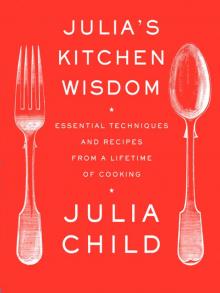 Julia's Kitchen Wisdom
Julia's Kitchen Wisdom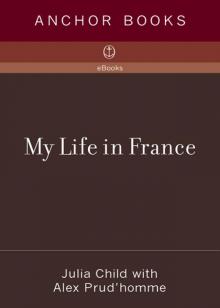 My Life in France
My Life in France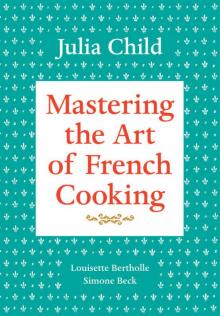 Mastering the Art of French Cooking, Volume 1
Mastering the Art of French Cooking, Volume 1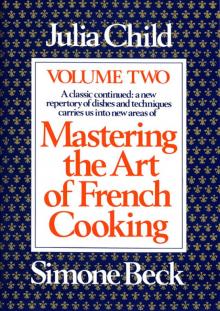 Mastering the Art of French Cooking, Volume 2
Mastering the Art of French Cooking, Volume 2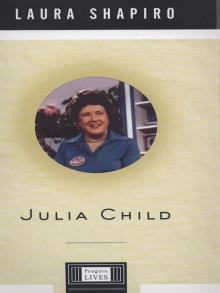 Laura Shapiro
Laura Shapiro